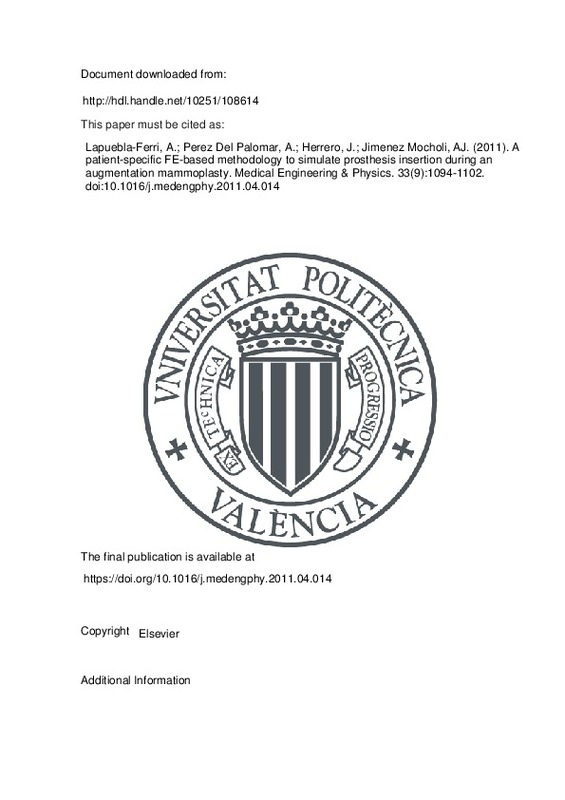JavaScript is disabled for your browser. Some features of this site may not work without it.
Buscar en RiuNet
Listar
Mi cuenta
Estadísticas
Ayuda RiuNet
Admin. UPV
A patient-specific FE-based methodology to simulate prosthesis insertion during an augmentation mammoplasty
Mostrar el registro sencillo del ítem
Ficheros en el ítem
| dc.contributor.author | Lapuebla-Ferri, Andrés
|
es_ES |
| dc.contributor.author | Perez del Palomar, Amaya
|
es_ES |
| dc.contributor.author | Herrero, Javier
|
es_ES |
| dc.contributor.author | Jimenez Mocholi, Antonio José
|
es_ES |
| dc.date.accessioned | 2018-09-29T04:31:51Z | |
| dc.date.available | 2018-09-29T04:31:51Z | |
| dc.date.issued | 2011 | es_ES |
| dc.identifier.issn | 1350-4533 | es_ES |
| dc.identifier.uri | http://hdl.handle.net/10251/108614 | |
| dc.description.abstract | [EN] Breast augmentation surgery is a widespread practice for aesthetic purposes. Current techniques, however, are not able to reliably predict the desired final aspect of the breast after the intervention, whose success relies almost completely on the surgeon's skill. In this way, patient-specific methodologies capable of predicting the outcomes of such interventions are of particular interest. In this paper, a finite element biomechanical model of the breast of a female patient before an augmentation mammoplasty was generated using computer tomography images. Prosthesis insertion during surgery was simulated using the theory of finite elasticity. Hyperelastic constitutive models were considered for breast tissues and silicone implants. The deformed geometry obtained from finite element analysis was compared qualitatively and quantitatively with the real breast shape of the patient lying in supine position, with root-mean-squared errors less than 3. mm. The results indicate that the presented methodology is able to reasonably predict the aspect of the breast in an intermediate step of augmentation mammoplasty, and reveal the potential capabilities of finite element simulations for visualization and prediction purposes. However, further work is required before this methodology can be helpful in aesthetic surgery planning. © 2011 IPEM. | es_ES |
| dc.description.sponsorship | The support of Instituto de Salud Carlos III (ISCIII) through the CIBER initiative, and the support of Platform for Biological Tissue Characterization of the Centro de Investigacion Biomedica en Red de Bioingenieria, Biomateriales y Nanomedicina (CIBER-BBN) are highly appreciated. The translation of this paper was funded by the Universitat Politecnica de Valencia, Spain. | en_EN |
| dc.language | Inglés | es_ES |
| dc.publisher | Elsevier | es_ES |
| dc.relation.ispartof | Medical Engineering & Physics | es_ES |
| dc.rights | Reserva de todos los derechos | es_ES |
| dc.subject | Breast augmentation | es_ES |
| dc.subject | Breast biomechanics | es_ES |
| dc.subject | Finite element method | es_ES |
| dc.subject | Hyperelastic behaviour | es_ES |
| dc.subject | Surgery planning | es_ES |
| dc.subject | Finite Element | es_ES |
| dc.subject | Hyper elastic | es_ES |
| dc.subject | Biomechanics | es_ES |
| dc.subject | Elasticity | es_ES |
| dc.subject | Forecasting | es_ES |
| dc.subject | Medical computing | es_ES |
| dc.subject | Prosthetics | es_ES |
| dc.subject | Silicones | es_ES |
| dc.subject | Surgery | es_ES |
| dc.subject | Tissue | es_ES |
| dc.subject | Visualization | es_ES |
| dc.subject | Adult | es_ES |
| dc.subject | Analytical error | es_ES |
| dc.subject | Article | es_ES |
| dc.subject | Biological model | es_ES |
| dc.subject | Breast prosthesis | es_ES |
| dc.subject | Computer assisted tomography | es_ES |
| dc.subject | Female | es_ES |
| dc.subject | Finite element analysis | es_ES |
| dc.subject | Human | es_ES |
| dc.subject | Implantation | es_ES |
| dc.subject | Physical parameters | es_ES |
| dc.subject | Prediction | es_ES |
| dc.subject | Priority journal | es_ES |
| dc.subject | Qualitative analysis | es_ES |
| dc.subject | Quantitative analysis | es_ES |
| dc.subject | Simulation | es_ES |
| dc.subject | Supine position | es_ES |
| dc.subject | Breast Implants | es_ES |
| dc.subject | Humans | es_ES |
| dc.subject | Individualized Medicine | es_ES |
| dc.subject | Mammaplasty | es_ES |
| dc.subject | Tomography | es_ES |
| dc.subject | X-Ray Computed | es_ES |
| dc.subject.classification | MECANICA DE LOS MEDIOS CONTINUOS Y TEORIA DE ESTRUCTURAS | es_ES |
| dc.title | A patient-specific FE-based methodology to simulate prosthesis insertion during an augmentation mammoplasty | es_ES |
| dc.type | Artículo | es_ES |
| dc.identifier.doi | 10.1016/j.medengphy.2011.04.014 | es_ES |
| dc.rights.accessRights | Abierto | es_ES |
| dc.contributor.affiliation | Universitat Politècnica de València. Departamento de Mecánica de los Medios Continuos y Teoría de Estructuras - Departament de Mecànica dels Medis Continus i Teoria d'Estructures | es_ES |
| dc.description.bibliographicCitation | Lapuebla-Ferri, A.; Perez Del Palomar, A.; Herrero, J.; Jimenez Mocholi, AJ. (2011). A patient-specific FE-based methodology to simulate prosthesis insertion during an augmentation mammoplasty. Medical Engineering & Physics. 33(9):1094-1102. https://doi.org/10.1016/j.medengphy.2011.04.014 | es_ES |
| dc.description.accrualMethod | S | es_ES |
| dc.relation.publisherversion | https://doi.org/10.1016/j.medengphy.2011.04.014 | es_ES |
| dc.description.upvformatpinicio | 1094 | es_ES |
| dc.description.upvformatpfin | 1102 | es_ES |
| dc.type.version | info:eu-repo/semantics/publishedVersion | es_ES |
| dc.description.volume | 33 | es_ES |
| dc.description.issue | 9 | es_ES |
| dc.relation.pasarela | S\202145 | es_ES |
| dc.contributor.funder | Instituto de Salud Carlos III | |
| dc.contributor.funder | Centro de Investigación Biomédica en Red en Bioingeniería, Biomateriales y Nanomedicina | |
| dc.contributor.funder | Universitat Politècnica de València |







![[Cerrado]](/themes/UPV/images/candado.png)

